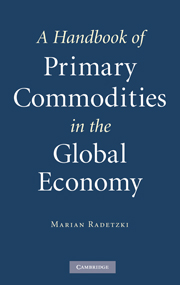Book contents
- Frontmatter
- Contents
- List of figures
- List of tables
- Acknowledgments
- Introduction
- 1 The historical framework
- 2 The geography of commodity production and trade
- 3 Comparative advantage and the trade policy distortions
- 4 Price formation and price trends in commodities
- 5 The commodity exchanges, commodity investments, and speculation
- 6 The economics of exhaustible resource depletion
- 7 Fears of, and measures to assure, supply security
- 8 Producer cartels in international commodity markets
- 9 Public ownership in primary commodity production
- 10 The monoeconomies: issues raised by heavy dependence on commodity production and exports
- References
- Index
2 - The geography of commodity production and trade
Published online by Cambridge University Press: 23 June 2009
- Frontmatter
- Contents
- List of figures
- List of tables
- Acknowledgments
- Introduction
- 1 The historical framework
- 2 The geography of commodity production and trade
- 3 Comparative advantage and the trade policy distortions
- 4 Price formation and price trends in commodities
- 5 The commodity exchanges, commodity investments, and speculation
- 6 The economics of exhaustible resource depletion
- 7 Fears of, and measures to assure, supply security
- 8 Producer cartels in international commodity markets
- 9 Public ownership in primary commodity production
- 10 The monoeconomies: issues raised by heavy dependence on commodity production and exports
- References
- Index
Summary
The agenda for this chapter comprises four items. The first section defines primary commodities and classifies them into a variety of distinct groups. These distinctions are indispensable for some of the analyses performed in the following chapters. The second section attempts to determine the significance of commodities in the international economy, at both the aggregate and individual product level. The third section paints a broad picture of the current geography of traded commodity production and consumption. The import dependence of the major industrial regions on overseas commodity supply is explored and quantified, and the most important commodity-exporting countries are identified in the process. Section four, finally, assumes a historical perspective and considers briefly the forces that have led to the increasing dependence of Western Europe, the US and Japan and, more recently, China, on commodity imports in the course of the twentieth century.
Commodity groups and their characteristics
The subject matter of this book is the world of raw materials, alternatively referred to as primary commodities and, for short, commodities. A first important task is therefore to distinguish commodities from other goods. This distinction may sound straightforward and clear, but however one proceeds, substantial ambiguities remain. Some of these were briefly touched upon in the preceding chapter.
The national accounts statistics of individual countries divide the GDP in accordance with the International Standard Industrial Classification (ISIC) of All Economic Activities, as designed by the United Nations Statistical Office.
- Type
- Chapter
- Information
- A Handbook of Primary Commodities in the Global Economy , pp. 22 - 46Publisher: Cambridge University PressPrint publication year: 2008



